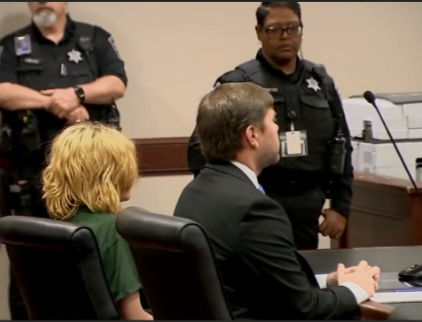In the wake of the devastating Georgia High School shooting, the nation is left reeling from the tragedy that claimed the lives of four individuals. The suspect, a 14-year-old boy, now faces murder charges. However, what makes this heartbreaking event even more disturbing is the apparent forewarning—a desperate call from the boy’s mother to the school counselor, raising an “extreme emergency” about her son.
Before the incident, the boy’s mother had reportedly reached out to the school, flagging concerning behavior that, in hindsight, foreshadowed the coming violence. According to family sources, the mother mentioned that her son had been acting unpredictably, though there is ambiguity about whether she explicitly warned the school that her son had brought a gun to campus. This raises urgent questions about the school’s response to her warnings. Did they take her seriously enough? Could swift action have averted the tragedy?
More information has since emerged about the boy’s background. Reports suggest a long history of bullying, as well as exposure to firearms—two factors that have often been present in cases of school violence. His mental state had deteriorated over time, exacerbated by social isolation and a lack of sufficient intervention. The situation highlights the importance of addressing bullying as a core issue in many school shootings, as perpetrators often emerge from environments where they feel powerless, marginalized, and without support.
Yet, the mother’s actions raise their own questions. Why didn’t she contact law enforcement if she knew her son might have been armed and dangerous? While her call to the school counselor reflected a mother’s desperation, it underscores the complexity of knowing when to escalate to authorities. Parents facing such difficult circumstances often fear criminalizing their children, even as they worry about their safety and the safety of others.
The school’s response, or lack thereof, to the mother’s plea has sparked widespread criticism. Were there protocols in place to handle such warnings? If the mother hinted at the presence of a weapon, was it enough for the school to act? It is too early to definitively state where the failure occurred, but it is clear that this tragedy has exposed weaknesses in how schools address warnings from parents and signs of troubled students.
Mental health support systems in schools have long been underfunded, and this case is a grim reminder of the consequences. Students in emotional distress are often not identified early enough, and even when concerns are raised, they may not be adequately addressed. But we must also recognize the systemic issues that go beyond the school system—issues that include access to firearms, the normalization of violence, and an often-inadequate societal response to bullying and trauma.
This shooting also speaks to the broader context of America’s gun culture and its intersection with adolescent mental health. It’s not just a school’s responsibility to intervene in cases like this—parents, law enforcement, and mental health professionals must work together to ensure at-risk youth are supported before they resort to extreme measures.
A Societal Failure, Not Just a School’s
While it’s easy to point fingers at the school for potentially missing the signs or not acting on the mother’s warning, this tragedy reflects a deeper, more entrenched problem. Schools are not equipped to be the sole safety net for young people in crisis, especially when external factors—such as access to guns, community violence, and persistent bullying—continue to fester unaddressed. The burden falls across multiple institutions, and without a coordinated approach, such warning signs will continue to slip through the cracks.
Research has consistently shown that students who engage in violent acts often have a history of being bullied themselves. This case fits a broader pattern seen in many school shootings. The underlying bullying issue is one that society has yet to fully confront. Efforts to prevent bullying have increased, but they often lack the systemic follow-through needed to identify and intervene with those who are most vulnerable. And in a country where gun access is often easier than access to adequate mental health care, the results are tragically predictable.
Where Do We Go From Here?
As the community grapples with the aftermath, the question becomes: How do we prevent this from happening again? While mental health resources in schools must be expanded, they cannot act alone. Schools need clearer protocols, but there must also be a broader societal commitment to addressing the root causes of such violence. This includes everything from reducing the prevalence of firearms to creating a culture of intervention that does not stigmatize or criminalize at-risk youth.
We must also consider the role of parents in these crises. The boy’s mother, despite raising alarms, may have been overwhelmed by her own feelings of helplessness. A stronger system of communication between parents, schools, and mental health professionals is necessary to intervene before a situation reaches a breaking point. But that system must be well-funded, comprehensive, and readily available to every child.
As we mourn the victims of this latest tragedy, we must reflect on the deeper issues at play. Bullying, mental health, and gun access all intersect in ways that create dangerous conditions for young people. Addressing just one piece of this puzzle is not enough; a holistic approach is necessary to ensure that no more families endure the pain of a preventable loss.

By Donte T. Nelson
The Neoliberal Journals
Edited and Published by: Renaldo C. McKenzie/The NeoLiberal Corporation September 9, 2024.
Subscribe to our YouTube Channel: The Neoliberal Round by Renaldo McKenzie
Check out our episode on Bail Reform Laws:
Neoliberalism book 1 goes onsale until October 31,2024. Get your copies while sale lasts.



